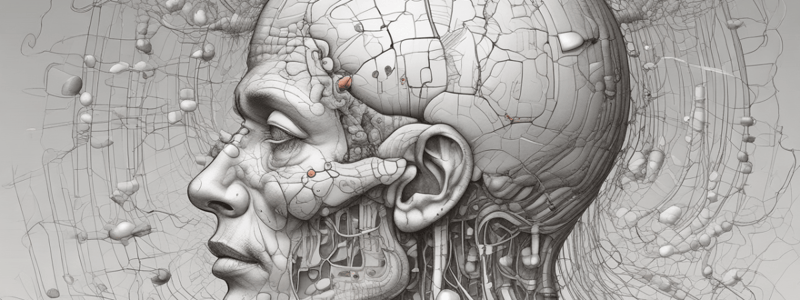Podcast
Questions and Answers
What is the main issue with current treatments for Parkinson's disease?
What is the main issue with current treatments for Parkinson's disease?
- They only address some symptoms, leaving others unaffected. (correct)
- They are not approved for elderly patients.
- They are too expensive for most patients.
- They are ineffective in treating postural imbalance.
What is the goal of providing L-DOPA infusion via a pump?
What is the goal of providing L-DOPA infusion via a pump?
- To completely eliminate dyskinesia.
- To increase dopamine levels in the brain.
- To reduce side effects of current treatments.
- To provide more consistent receptor activation. (correct)
What is a major unmet need in the treatment of Parkinson's disease?
What is a major unmet need in the treatment of Parkinson's disease?
- Developing neuroprotective or repair treatments. (correct)
- Increasing the availability of treatments for elderly patients.
- Improving the effectiveness of current treatments.
- Reducing the cost of current treatments.
What is a significant risk associated with Parkinson's disease, particularly in elderly patients?
What is a significant risk associated with Parkinson's disease, particularly in elderly patients?
What is a potential approach to managing Parkinson's disease, as suggested by Crossman AR (2000)?
What is a potential approach to managing Parkinson's disease, as suggested by Crossman AR (2000)?
What is the primary movement deficit in Parkinson's disease due to?
What is the primary movement deficit in Parkinson's disease due to?
What is the primary neurotransmitter involved in motor control in the basal ganglia circuit?
What is the primary neurotransmitter involved in motor control in the basal ganglia circuit?
What is the primary factor that increases the risk of developing Parkinson's disease?
What is the primary factor that increases the risk of developing Parkinson's disease?
What is the primary effect of dopamine depletion on the basal ganglia circuit?
What is the primary effect of dopamine depletion on the basal ganglia circuit?
What is the primary rationale behind the use of dopamine agonists in Parkinson's disease treatment?
What is the primary rationale behind the use of dopamine agonists in Parkinson's disease treatment?
What is the primary consequence of the loss of dopamine innervation to the basal ganglia in Parkinson's disease?
What is the primary consequence of the loss of dopamine innervation to the basal ganglia in Parkinson's disease?
What is the effect of muscarinic receptor antagonists on striatal cholinergic interneurones?
What is the effect of muscarinic receptor antagonists on striatal cholinergic interneurones?
What is the primary mechanism by which dopamine influences movement in the basal ganglia?
What is the primary mechanism by which dopamine influences movement in the basal ganglia?
What is the consequence of increased GABAergic signaling at thalamic relay nuclei in Parkinson's disease?
What is the consequence of increased GABAergic signaling at thalamic relay nuclei in Parkinson's disease?
What is the primary effect of SNc degeneration on the basal ganglia motor circuit?
What is the primary effect of SNc degeneration on the basal ganglia motor circuit?
What is the primary effect of MAO-B inhibitors on dopamine metabolism?
What is the primary effect of MAO-B inhibitors on dopamine metabolism?
What is the potential benefit of using dopamine receptor agonists in the treatment of Parkinson's disease?
What is the potential benefit of using dopamine receptor agonists in the treatment of Parkinson's disease?
What is the advantage of using dopamine receptor agonists over L-DOPA in terms of receptor stimulation?
What is the advantage of using dopamine receptor agonists over L-DOPA in terms of receptor stimulation?
What is the purpose of using 'L-DOPA sparing' strategies in the treatment of Parkinson's disease?
What is the purpose of using 'L-DOPA sparing' strategies in the treatment of Parkinson's disease?
What is the potential advantage of using alternative routes of drug administration, such as the rotigotine patch?
What is the potential advantage of using alternative routes of drug administration, such as the rotigotine patch?
Flashcards are hidden until you start studying
Study Notes
Basal Ganglia Pathways
- Direct pathway: activated by dopamine (D1), facilitates movement
- Indirect pathway: inhibited by dopamine (D2), inhibits movement
- In Parkinson's disease: direct pathway underactive, indirect pathway overactive
- Consequence: reduced thalamocortical feedback, resulting in reduced movement
Changes in Basal Ganglia Pathways in Parkinson's
- SNc degeneration: loss of dopamine innervation to basal ganglia
- Glutamate innervation from cortex intact
- Direct pathway: underactive, indirect pathway: overactive
- Increased firing of striatal cholinergic interneurons
Parkinson's Disease
- Age-related neurodegenerative disorder, first described in 1817
- Affects 0.5% of the population, 2% of those over 80 years
- Incidence: 1.5 times more likely in males
- Motor symptoms: resting tremor, postural instability, bradykinesia, rigidity
- Non-motor symptoms: REM sleep disorder, autonomic dysfunction, cognitive decline, pain
Current Drug Treatments for Parkinson's
- Anticholinergic drugs (muscarinic receptor antagonists): e.g. benzhexol, benzatropine
- Action: block increased acetylcholine (ACh) contributing to tremor
- Effective against resting tremor, minimal effect on bradykinesia and rigidity
- Side effects: central (confusion, mood changes), peripheral (e.g. dry mouth)
MAO-B Inhibitors
- Inhibit dopamine metabolism, prolonging dopamine activity
- Used as monotherapy in early stage PD to boost remaining DA activity
- Used as an adjunct to lower L-DOPA dose in later disease (L-DOPA sparing)
- Examples: selegiline, rasagiline
Dopamine Receptor Agonists
- Produce effects mainly through activation of striatal D2 receptors
- Acute side effects: similar to L-DOPA
- Chronic side effects: less incidence of dyskinesia
- Used first or after MAO-B inhibitors stop being effective
- Examples: bromocriptine, ropinirole, pramipexole
Alternative Routes of Drug Administration
- Rotigotine (dopamine agonist) patch: effective as monotherapy in early PD
- Duo-dopa: intraduodenal pump to produce continuous infusion of L-DOPA
- Reduces dyskinesia, provides less fluctuation in receptor stimulation
Studying That Suits You
Use AI to generate personalized quizzes and flashcards to suit your learning preferences.




